
- Capital City:
- Hartford
- Nickname:
- Constitution State / Provision State / Nutmeg State
- Motto:
- Qui transtulit sustinet(He who transplanted still sustains)
- Statehood:
- January 9, 1788 (5th)
- Origin of state's name:
- Based on the Mohegan word, Quinnehtukqut, meaning "Long River Place" or "Beside the Long Tidal River"
- Largest Cities:
- Bridgeport, Hartford, New Haven, Stamford, Waterbury
- Border States:
- Massachusetts, New York, Rhode Island
- Land Area:
- 4,845 sq. mi.; 48th largest
- State Bird:
- Robin
- State Flower:
- Mountain laurel (kalmia latifolia)
- State Tree:
- White Oak (quercus alba)
- State Song:
- Yankee Doodle
One of the original 13 states, Connecticut is known as the "Constitution State." It gets its name from an Algonquian word meaning "land on the long tidal river." Hartford has been the capital of Connecticut since 1875 and the state flower is the mountain laurel.
Monday Night Jazz Series and Greater Hartford Festival of Jazz
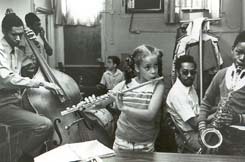
If you were to go to Hartford, Connecticut, on a Monday night in the summer, you could attend the oldest continually running jazz series in the country. The kids you see in this photo are practicing, or in jazz lingo, jamming, for the Monday Night Jazz Series.
As the sun goes down and the stars come out, you can listen to the uniquely American musical form of jazz at the Monday Night Jazz Series in Bushnell Park, in Hartford. This summer concert series presents nationally and internationally renowned musicians as well as local talent in celebration of all kinds of jazz music. Many levels of performers -- from cutting-edge artists to youth from local schools -- take part in the series.
Run by volunteers, the series has been held in Bushnell Park since 1966. The Greater Hartford Festival of Jazz, a weekend of free performances, was initiated in 1991by the organizers of the Monday Night Jazz Series, in honor of its 25th anniversary.
Connecticut's State Song
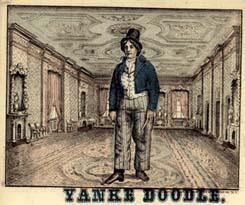
How did a song help the Colonial soldiers win the Revolutionary War?
Connecticut's state song is "Yankee Doodle." This popular song has an unusual history. The words were apparently written by an Englishman during the French and Indian War in 1755. Originally, the tune made fun of the poorly dressed and ill-equipped New England soldiers. During the Revolutionary War with England, however, Americans slightly rewrote the words to make fun of the British soldiers. The song boosted the soldiers' morale (pronounced "more-al"; it refers to a person's enthusiasm or mood) and was a source of pride for the American soldiers. Good morale is important during a war so that people don't get discouraged and give up. Anything that could be done to boost morale was a good idea.
Parade Spectacular
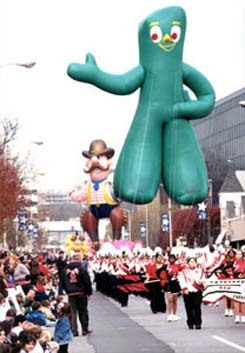
Have you ever seen a parade with floating balloons in the shape of characters like Gumby or Dick Tracy? Do you know why such big balloons float in the air? It's because they are filled with helium, and helium gas is lighter than air so it floats.
Gumby, Dick Tracy, Rocky and Bullwinkle, and many other giant balloon characters float through downtown Stamford, Connecticut, in the annual Parade Spectacular. The festivities include marching bands, dancers, and more. The parade falls at the same time as other holiday events in town, from the lighting of the Christmas tree to a North Pole adventure land in Latham Park.
Stamford's annual holiday balloon parade started six years ago as a small, hometown affair and has become one of the largest helium balloon parades in the country, with 30 giant helium balloons floating above the city and people coming from all over the region to see them. In 1999, there were an estimated 250,000 spectators.
Sisu and Creativity-The Essence of Finnish Immigrants in Eastern Connecticut
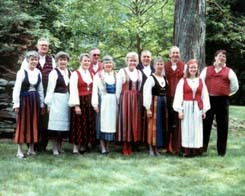
Do you have sisu? Have you ever even heard of it before? Sisu is a Finnish word that describes someone who works hard and has determination and perseverance.
This word came to America with Finnish immigrants who began to settle in Connecticut in the 1920s. The immigrants were escaping poverty at home and looking for land, which they were able to buy cheaply from Yankee farmers. Because they had sisu they became successful in their new community.
Finnish sisu helped the immigrants farm rocky land and hand-pour cement foundations for their homes and other buildings. Many made a decent living selling chickens and eggs. Their hard work and perseverance also helped them build social halls where immigrants could meet others with similar backgrounds and languages. A group called the Finnish American Education Association bought land and built social halls in various parts of Connecticut.
In 1987, inspired by a desire to prevent the sale of their Finnish hall for unpaid taxes, the Finnish American Heritage Society was formed in Canterbury. To this day their mission is to promote Finnish heritage, culture and language -- all of which they do with a combination of hard work, determination, and perseverance.
The next time you have a very difficult job to do, think sisu!
The Mark Twain House
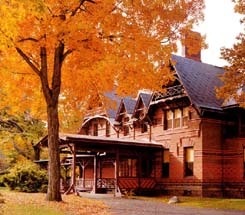
Can a house have a heart and soul? Can people love their house even if others think it's odd?
In 1871, writer Mark Twain moved to Hartford, Connecticut, to be closer to his publisher. He rented a home in Nook Farm, a thriving literary community at the western edge of Hartford. In 1873, Twain, whose real name was Samuel Langhorne Clemens, and his family purchased land on Farmington Avenue in Nook farm and hired a New York City architect to design a house.
As the house was being built, the local newspaper noted that "it is one of the oddest looking buildings in the state ever designed for a dwelling, if not in the whole country."
Twain once said that the house "had a heart, and a soul. ... It was of us, and we were in its confidence and lived in its grace and in the peace of its benediction. We never came from an absence that its face did not light up and speak out its eloquent welcome -- and we could not enter unmoved."
Twain lived and worked in the house from 1874 to 1891. During this time he wrote The Adventures of Tom Sawyer, The Adventures of Huckleberry Finn and A Connecticut Yankee in King Arthur's Court. Do you think his unique house influenced his writing?
 Print
Print Email
Email







